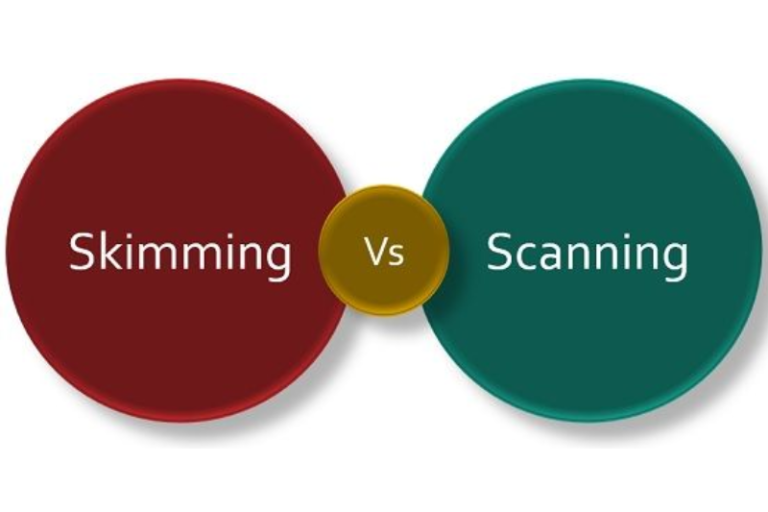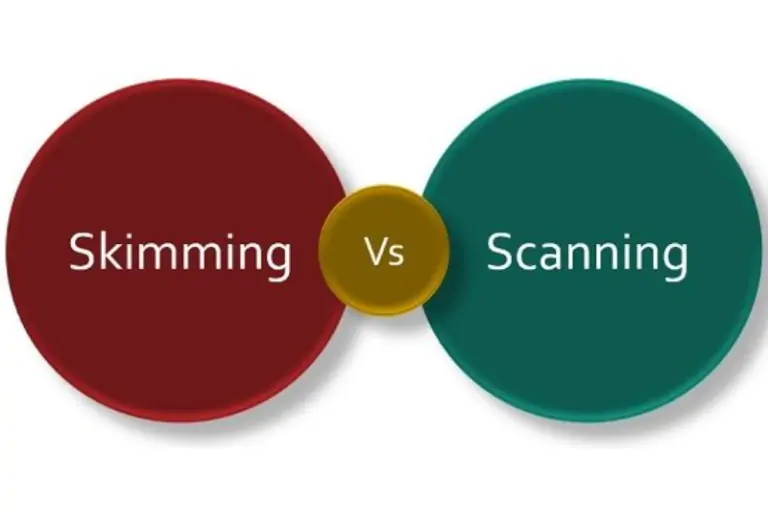

exploring 10 differences between skimming and scanning
Last updated on May 10th, 2024 at 03:15 pm
When referring to reading or studying, skimming and scanning are relative terms. In actuality, they are ways to access the data included in study materials. While scanning is the process of swiftly going over the study material with the deliberate effort to locate something, skimming is the act of reading fast and thereby bypassing certain elements.
Skimming is a rapid reading or information processing method where the focus is on the main ideas of the text and less on the specifics. Reading at a rate far faster than typical reading is what distinguishes it. Skimming allows well-trained eyes to identify and concentrate on pertinent portions of the content while ignoring portions that are not essential for the requisite degree of understanding.
Skimming is used to get a general idea of the content. It involves quickly glancing over the text to identify the main points, key ideas, and overall structure. Scanning is employed to locate specific details or information within a text. It involves moving your eyes rapidly across the text to find particular words, phrases, or numbers.
Skimming is a rapid reading technique where readers focus on headings, subheadings, topic sentences, and other prominent features while quickly moving through the text. Scanning involves even faster eye movements, as readers search for specific words, names, dates, or other details without reading every word.
Skimming provides a superficial understanding of the text, offering an overview of the main ideas and themes. Scanning allows for a deeper understanding of specific details or information within the text, as readers actively search for particular elements.
Skimming is often used for longer texts, such as articles, reports, or books when readers want to grasp the main points quickly. Scanning is useful for shorter texts or documents, such as directories, indexes, or schedules, when readers need to locate specific information swiftly.
Skimming techniques include reading the title, introduction, and conclusion, as well as scanning headings, subheadings, and bullet points. Readers may also focus on the first and last sentences of paragraphs to capture the main ideas.
Scanning techniques involve moving your eyes horizontally and vertically across the text in a zigzag pattern, looking for target words or phrases. Readers may also use visual cues, such as bold or italicized text, to identify relevant information quickly.
Skimming requires readers to consider the broader context of the text and infer meaning based on the information provided. Scanning is more focused and task-oriented, as readers search for specific details without necessarily considering the surrounding content.
Skimming typically involves a moderate reading speed, allowing readers to cover a significant amount of material in a relatively short time. Scanning requires a faster reading speed, as readers move quickly through the text to find specific information within a limited timeframe.
Skimming may result in lower retention of details, as readers prioritize speed over depth of understanding. Scanning can lead to higher retention of specific information, as readers actively search for and focus on relevant details.
Skimming is useful when previewing texts to determine their relevance or when reviewing material for a general understanding. Scanning is valuable when searching for specific information, such as dates, names, addresses, or keywords, within a document or text.
Skimming and scanning are often used together to optimize reading efficiency and comprehension. Skimming can help readers identify which sections of a text are most relevant for scanning, while scanning enables readers to extract specific details or information quickly.
To sum up, there are two different but complimentary ways to read: skimming and scanning. Each helps improve reading comprehension and efficiency. Through comprehension of the distinctions between skimming and scanning, as well as knowing when to use each method, readers may enhance their capacity to efficiently collect information from a variety of written materials.
Through their joint venture with Nvidia, Cassava Technologies creates the first African AI production facility to help local inventors. Cassava…
On Friday, South Africa's government leaders warned that President Trump's wide trade tariff policies have zeroed out Africa's AGOA benefits.…
The Gujarat Titans (GT) team confirmed Thursday that fast bowler Kagiso Rabada is taking an early IPL 2025 exit to…
The International Finance Corporation gives Raxio Group $100 million to accelerate their data center building efforts throughout Sub-Saharan African regions.…
The Oklahoma City Thunder secured their tenth consecutive victory by beating the Chicago Bulls 145-117. This victory raised their season…
The Board of Control for Cricket in India introduced a detailed list of cricket matches that will take place at…
This website uses cookies.